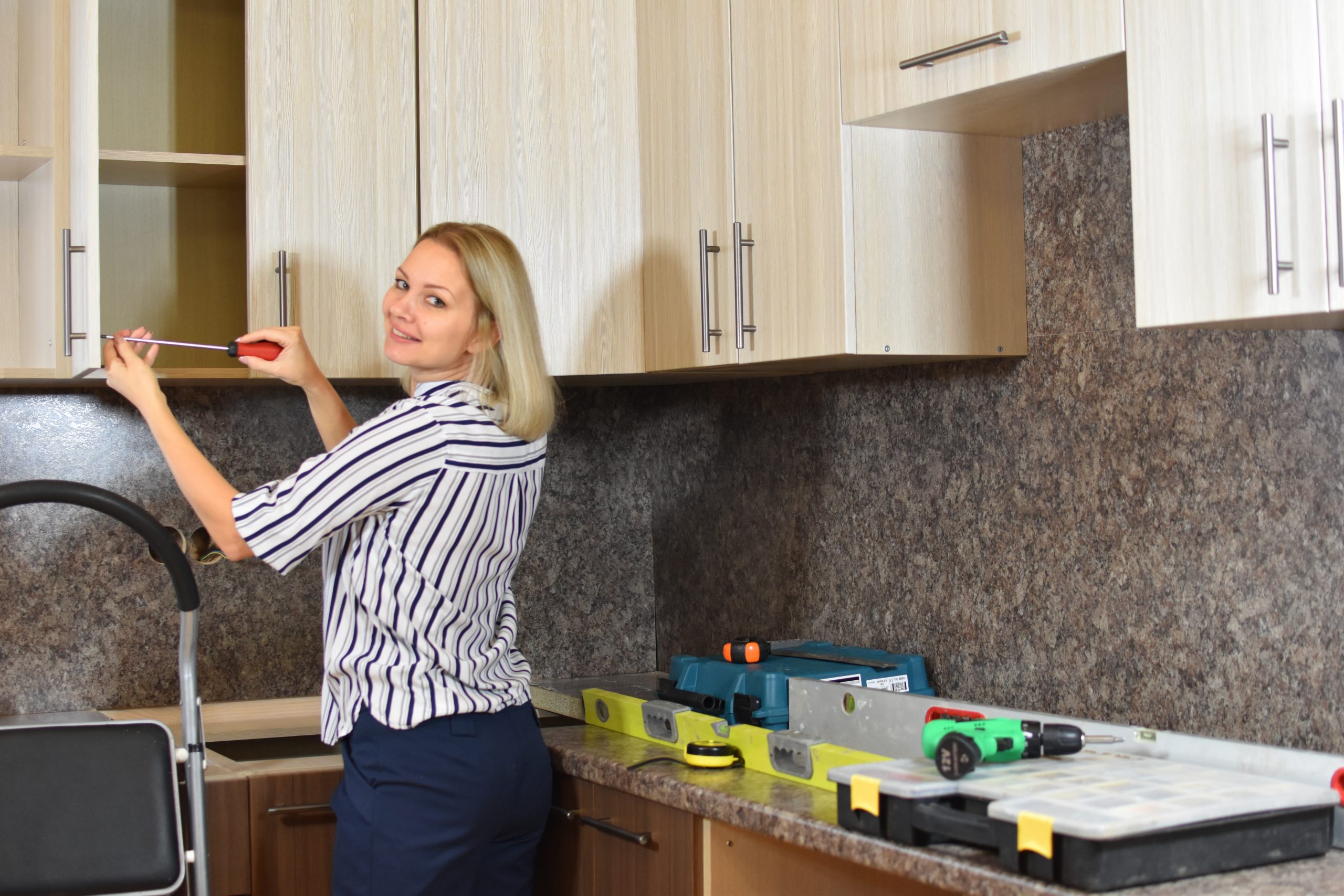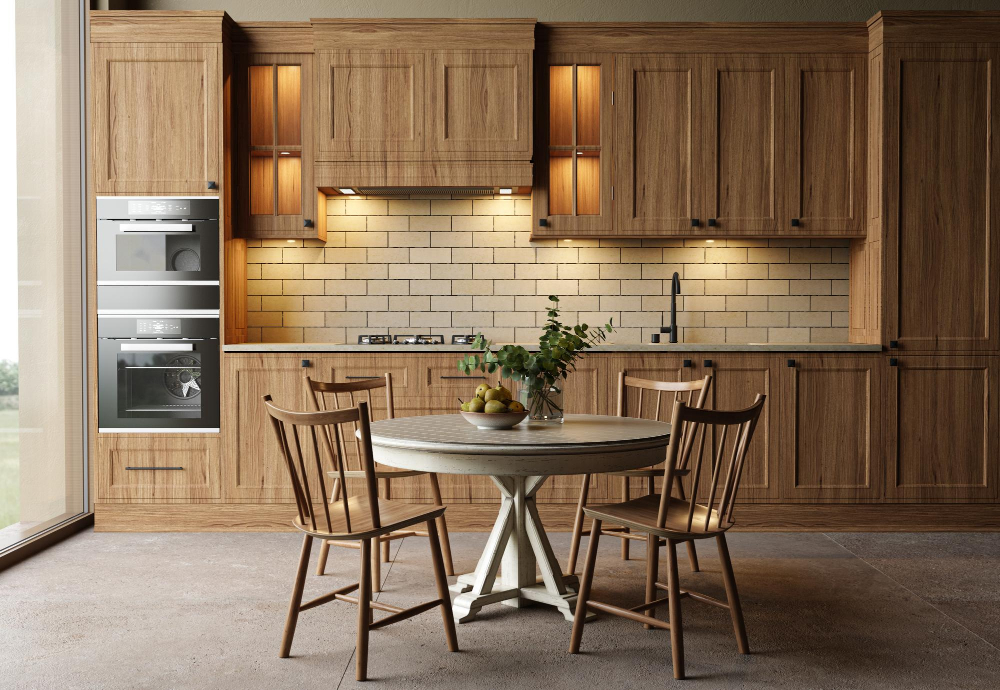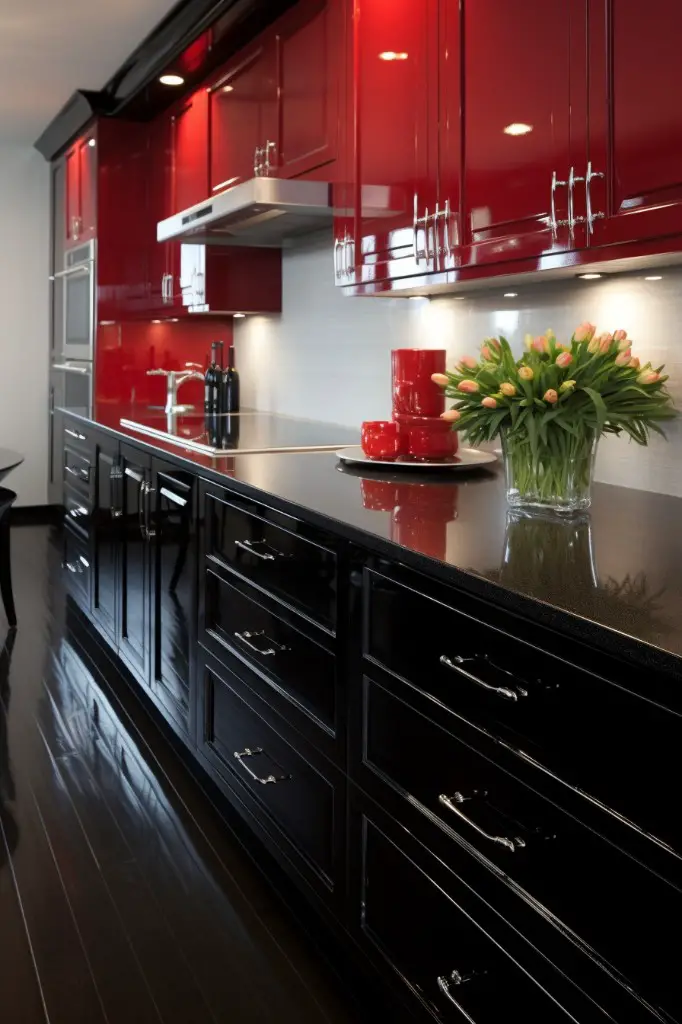Last updated on
Modernizing cathedral cabinets is achievable because it transforms your kitchen into a contemporary, stylish space, exciting details of which will unfold in this article.
Breathing new life into your dated cathedral cabinets can be a transformative endeavor. This involves several integrative steps such as changing the hardware, painting with a fresh color, and adding a modern touch like glass inserts.
This article will serve as an enlightenment to those seeking to modernize their cathedral cabinets by offering a detailed guide on each of these steps. Adhering to the outlined suggestions will provide you with an authentic yet captivating result, promising to turn your cabinets into a modern marvel.
Key takeaways:
- Choose specialized cabinet paints for durability and a modern appeal.
- Properly prepare cabinets by cleaning, sanding, and protecting the workspace.
- Apply a primer before painting to ensure adhesion and a professional finish.
- Consider trending colors, bold colors, wood stains, or dark colors for a modern look.
- Update hardware with sleek and minimalist designs in materials like brushed nickel or matte black.
What's Inside
Understanding Cathedral Cabinets
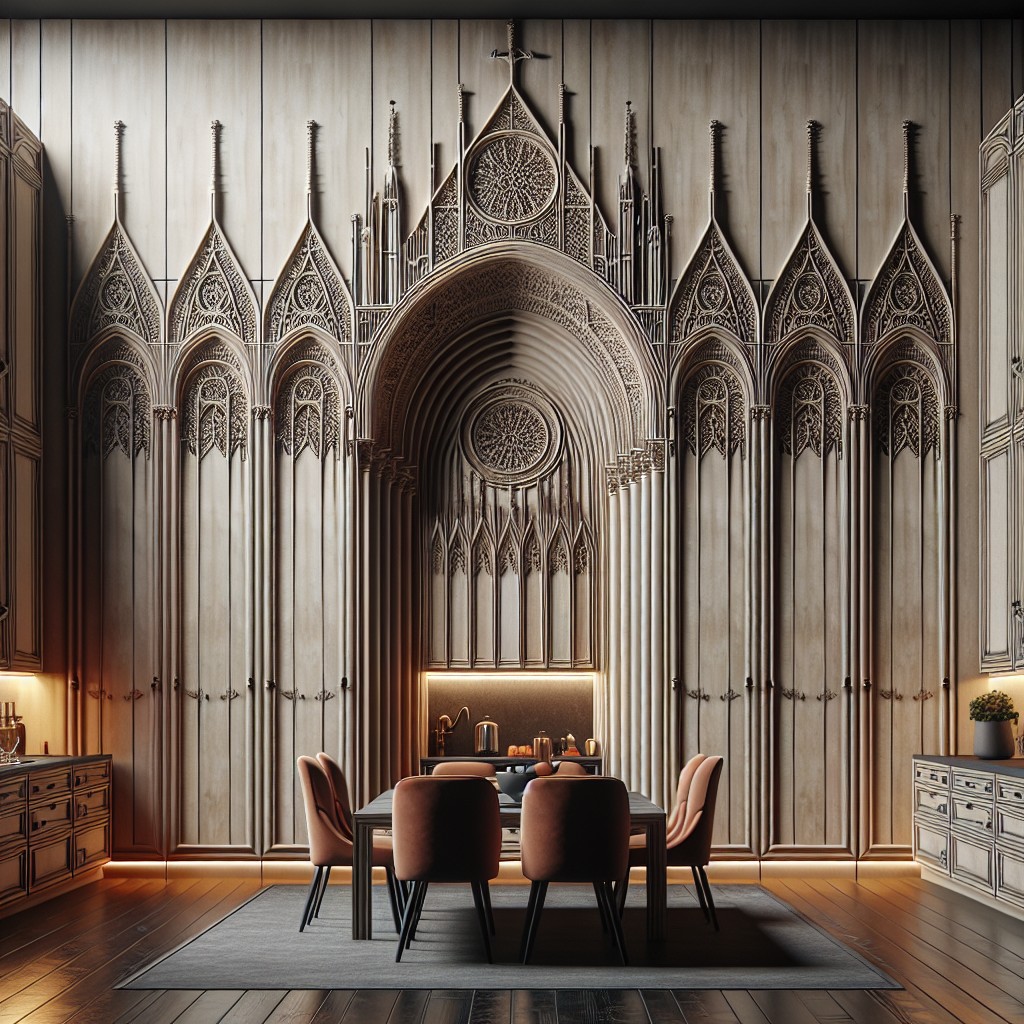
Cathedral cabinets are an enduring design that features prominent arched detailing on their doors, often paired with a traditional aesthetic. They were named due to the arch’s resemblance to the architecture of classic cathedrals. Generally, the arch is applied on the top half of the cabinet door, giving it a distinctive character that softens the lines of the kitchen.
Known for their ability to make massive spaces feel cozy, these cabinets are often associated with a more traditional or country-style decor. However, they are versatile and can be tweaked to fit a wide range of kitchen styles, including contemporary and minimalist designs.
It is important to note that due to the intricate detailing and traditional aesthetics, modernizing these cabinets often involves removing or altering the arch detail to make the design clean, simple, and uncluttered. Understanding their basic structure and how they integrate into your kitchen’s overall design will aid in a successful modernization project.
Selecting the Right Paint for Cabinet Refurbishment
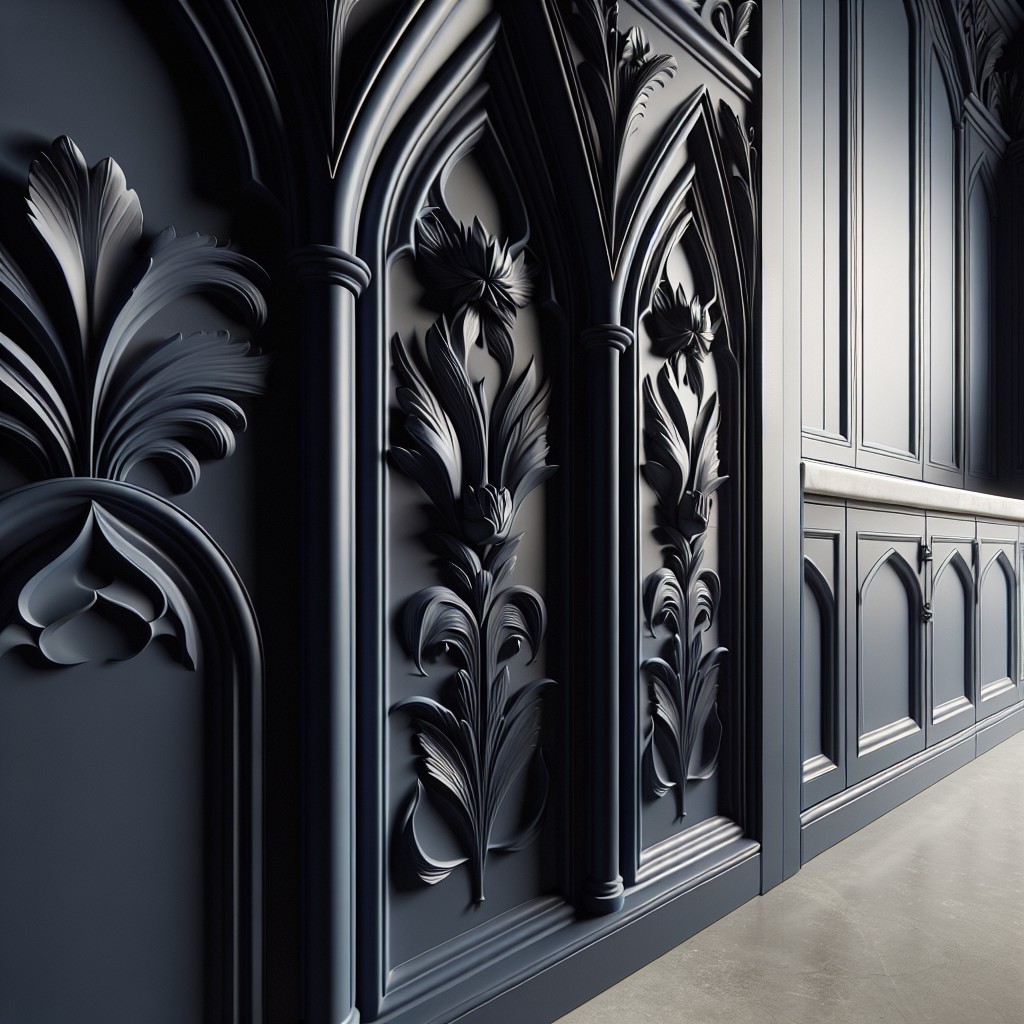
Always opt for specialized cabinet paints for durability and smooth finish. These paints are developed with cabinets in mind, hence they offer resistance against common issues such as chipping, staining, and standing up to frequent cleaning.
Acrylic, alkyd, and urethane paints are popular choices due to their sturdy, low-maintenance finish. They are also known for being self-leveling, meaning they smooth out brush or roller marks as they dry. Opting for semi-gloss or gloss finish adds to the modern appeal and further simplifies cleaning.
Finally, ensure the chosen paint is compatible with the primer or undercoat. Proper combination ensures longevity of the paint and an overall smooth, clean finish. These factors, alongside color choices, will take your cathedral cabinets from classic to modern with a stroke of a brush.
Preparing Cabinets for Modernization
Before diving into painting or refacing, ensure the cathedral cabinets are well-prepared. Start by removing all the cabinet doors and drawer fronts along with their hardware. This makes it simpler to work on each piece individually. Use a screwdriver to remove hinges and knobs. Be careful not to damage the cabinets or doors in the process.
Next comes cleaning. Over time, cabinets accumulate a lot of dirt, grease, and dust. Use a mild detergent and warm water to thoroughly clean the surfaces of the cabinets. Pay extra attention to the areas around knobs and handles as it’s common for grime to build up there.
After your cabinets are clean, it’s time to sand. This step is crucial, as it helps the paint adhere more effectively. Use fine-grit sandpaper to lightly go over each part of the cabinets. Opt for an electric sander for large surfaces as it can save time and effort.
Lastly, ensure the workspace is ready for the refurbishing process. Cover the countertops and floors with a drop cloth to protect them from potential paint spills and drips. Well-prepared cabinets are the foundation of a successful modernization project.
Applying Primer to Cathedral Cabinets
Before brushing on your chosen paint, primer application is an essential step. It ensures proper adhesion of the paint to the surface and enhances the durability of the finished product. Given the unique grooves and peaks in cathedral style cabinets, a spray primer is advisable for a more even coverage.
Here are some key points to consider:
- Clean the Cabinets: Begin by removing dust, grease, or any remnant of old paint to facilitate better primer adherence.
- Choose the Right Primer: Opt for a stain-blocking primer to hide any old stains and prevent new ones from soaking through the paint.
- Spraying Technique: Ensure light and even spraying to increase coverage area and decrease the chance of drips or accumulation in intricate design elements.
- Primer Drying Time: Allow adequate drying time before applying paint. Depending on the brand and environmental conditions, this may vary.
Following these steps makes the application of the actual paint color easier and allows for a professional, long-lasting finish.
Choosing Cabinet Paint Color
Arriving at the perfect color for your cabinets can be an adventure. But don’t fret, here are some ideas to help you make the selection:
1. Trending Colors: Current trends lean towards neutral tones like whites, grays, or off-whites. These provide a timeless appeal and work well with a vast array of kitchen styles.
2. Bold Colors: If you desire a lively, vibrant kitchen, consider daring colors like royal blue or emerald green. Be warned, these stand-out shades will make your cabinets the centerpiece of the kitchen.
3. Wood: If you’re aiming for a natural, rustic feel, consider a clear coat or light stain to highlight the wood beneath.
4. Dark Colors: Sophistication and elegance ooze from cabinets painted in dark tones such as black or navy blue. Keep in mind, a dark color might darken your space and is best used if there’s sufficient light.
Remember to test a swatch of the color on a cabinet door, with your chosen finish, before diving in. Viewing it in different lights and times of the day can significantly help in finalizing the most suitable selection.
Refacing: A Modern Solution for Cathedral Cabinets
Refacing, a highly desirable method for modernizing cathedral cabinets, offers a myriad of benefits. With this method, you retain the entire existing cabinetry framework and simply replace the doors and drawer fronts. It’s a perfect option if your cabinet boxes are still in good shape.
Here are key points explaining this concept:
- 1. Economical: Refacing proves less expensive than a full cabinet replacement, requiring fewer materials and less labor.
- 2. Time-saving: This process generally takes a fraction of the time spent replacing the entire cabinetry structure, meaning your kitchen won’t be out of commission for long.
- 3. Flexibility: This process allows for a complete transformation. You can change the wood type, color, or even switch to a more contemporary door style.
- 4. Sustainable: By keeping the existing cabinet boxes, you prevent unnecessary waste, thus being environmentally responsible.
Additionally, professional support is recommended for refacing, as precision is key for a polished finish. However, for the seasoned DIY enthusiast, numerous tutorials and step-by-step guides are available online.
Staining Techniques for an Updated Look
For an alternative to painting, consider staining your cabinets for a fresh and updated look. First, select a stain color that complements the overall design theme in your kitchen. Light stains such as oak and maple bring out the wood’s natural beauty and provide a contemporary feel, while dark stains like mahogany or espresso give the cabinets a more luxurious and sophisticated appearance.
Once you’ve decided on a shade, remove any existing coating from your cabinets using a chemical stripper. It’s crucial to follow the safety instructions on the product label, use appropriate protective gear, and ensure proper ventilation.
After stripping and cleaning, apply the stain. Use a soft cloth or a brush, apply the stain evenly, following the lines of the wood grain for the best result. Let the stain sit for a few minutes to penetrate the wood before wiping off any excess with a clean cloth.
This process might need to be repeated to achieve the desired shade. One coat generally offers a lighter color, while multiple coats tend to provide a darker hue. Remember to leave plenty of drying time in between each coat for the best result.
Finally, consider sealing your newly stained cabinets with a topcoat. Clear polyurethane or lacquer works perfectly for this purpose. The sealant will protect your cabinets against wear and tear while enhancing the natural brilliance of the wood.
Do take note that staining is a meticulous, time-consuming process and will not cover up flaws on the wood surface as effectively as paint might. However, it’s a great way to showcase the natural beauty of your wooden cathedral cabinet while injecting modern charm into your kitchen.
Hardware Choices for a Modern Appeal
Steering the design of your cathedral cabinets towards modernity rests heavily on your hardware choice. Do not skimp on detail.
High-quality pieces underline a sleek, contemporary feel. Go for streamlined and minimalist aesthetics: think simple knobs and bar pulls in materials like brushed nickel or stainless steel. For a dramatic touch, you can venture into matte black hardware.
On another note, hidden hinges promote a clean-lined look, liked by lovers of modern design. They are installed inside the cabinet, making them invisible when the door is closed.
The position of your hardware is equally critical. Generally, knobs or pulls for base cabinets are centered horizontally and placed roughly 1/3rd from the top of the door. For upper cabinets, center them horizontally and position about 1/3rd from the bottom for ease of access.
Lastly, consider comfort and function. While small, dainty pulls may look high-end and modern, they may not be the best fit for a kitchen used daily. Larger pulls, on the other hand, are easier to grip. Rings or knobs are excellent for doors, while drawers can accommodate pulls and handles of various sizes. Keep in mind to please the eyes but also the hands!
Innovative Arch Design Ideas for Kitchen Cabinets
Choosing an arch design that greatly complements your kitchen’s existing aesthetic is an excellent way to modernize cathedral cabinets. There are several design options worth considering:
- 1. Simplified Arch: For minimalistic kitchens, simplified or flat arch designs offer a sleek, modern appeal.
- 2. Gothic Arch: It adds an element of sophistication and works brilliantly with kitchens having high ceilings or dark colored designs.
- 3. Interior Lighting: Incorporating under-cabinet lighting or tastefully placed LEDs can highlight these beautiful arch designs.
- 4. Compact Double Arch: Appropriate for smaller kitchens, this design utilizes space efficiently while maintaining the cabinet’s charm.
- 5. Glass Panel: Replace the wooden arch’s panel with a decorated glass to achieve a modern, fresh look.
Remember, the key objective of the arch design is to add character to the kitchen while fitting harmoniously within its overall style.
Environmental and Economic Benefits of Updating Rather Than Replacing
Refurbishing existing cathedral cabinets significantly aids in reducing ecological footprint by minimizing waste that fills up landfills. Since we’re not employing newly harvested wood, we conserve natural resources and significantly reduce the consumption of energy involved in production of fresh cabinets.
Another advantage is saving haul-away fees and the costs of installing new cabinets. Undertaking a refurbishing project can cut your expenses by as much as 50% compared to buying new. With carefully selected materials and a beautifully executed modernization plan, your cabinets might even look better than new ones.
Moreover, refurbishing can add substantial value to your home. A modern, stylish kitchen attracts potential buyers, and the fact that the cabinets have been responsibly updated rather than replaced can be a unique selling point. This method slots right into getting a good deal in today’s green-friendly market.
Lastly, it gives you a chance to put a personal touch on a pre-used item, combining DIY enthusiasm with economic savvy and an environmental consciousness.
Hands-on Project: Updating Cathedral Cabinet Doors With DIY Instructions
To embark on this home project, gather the necessary tools and materials: a screwdriver, sandpaper, primer, paint, and a clean cloth.
Start by removing the cabinet doors using the screwdriver.
Sand the surface gently to create a suitable base for the primer.
Ensure the surface is smooth by feeling with your hand before applying the primer.
Next, proceed with a layer of primer.
This helps to seal the wood and provide a solid base for the paint.
Allow the primer to dry completely before you start painting.
At this stage, choose a paint color that complements your kitchen aesthetics.
Apply paint evenly without leaving streaks for the best result.
You may need to repeat this process with a second coat of paint to achieve the desired color saturation.
Allow adequate drying time before reattaching the cabinet doors back.
Patience is key here – ensure the paint is completely dried to prevent chips or smears.
Finally, remember to clean your tools immediately after use for easier maintenance.
This is a simple and straightforward project to give cathedral cabinets a fresh, modern look.
Enjoy every step, knowing you’re creating a kitchen that reflects your personal style.
Strategic Lighting to Accentuate Modern Cabinets
Lighting plays a significant role in showing off newly modernized cabinets. Its strategic use not only adds depth and dimension but also creates a warm and inviting atmosphere.
Consider installing under cabinet lighting. It illuminates the countertops, making it easier to prepare meals, while enhancing the characteristics of the cabinets. Go for LED lights that are energy-efficient, long-lasting, and offer a variety of color temperatures to enhance different wood tones.
Recessed downlights in the ceiling provide overall room light, while spotlighting your cabinet design. The placement and number should be carefully planned to avoid shadows on work surfaces.
For an extra touch of elegance, interior cabinet lighting can be installed. This works exceptionally well with glass-fronted cabinets, creating an appealing shine through the transparent sections.
Remember, the aim is to highlight your cabinets, not dazzle everyone in the room. Therefore, choose fixtures with dimmer switches. This way, you can control the amount of light, creating a subtle glow that will not overwhelm the space. Plus, it lets you change the mood depending on the time of day or occasion.
When chosen carefully and positioned correctly, lighting can become a powerful tool to showcase the beauty and elegance of your modernized cathedral cabinets.
Maintaining Your Modernized Cabinets
To keep your cabinets looking new, regular cleaning is key. Use a gentle, non-abrasive cleaner to avoid scratching the surface. Wipe up spills immediately so they don’t leave marks.
Deep clean at least once a year. Remove everything from the cabinets and clean the interior and exterior thoroughly.
Even stainless steel hardware can tarnish over time. Polish them occasionally with a suitable cleaning agent for best results.
Avoid overloading the shelves. Too much weight can warp the structure over time. Divide belongings evenly and don’t exceed the capacity.
Minor scratches or chips? Touch them up promptly with a matching paint or stain. This prevents the damage from spreading and keeps your cabinets looking their best.
For cabinets near the stove or sink, be extra cautious with heat and humidity. Consider installing a heat shield and ensure good ventilation to minimize the effects of moisture.
In the long run, good maintenance not only sustains the appearance, but also extends the lifespan of your cabinets. Regular check-ups to identify any signs of wear and tear helps preserve your freshly modernized cabinets. Ultimately, it ensures that your kitchen remains a visually appealing, functional space for many more years to come.
Effective Use of Trim in Modernizing Cathedral Cabinets
To effectively utilize trim when updating your cabinets, one needs to consider the right profile and finish. Crown molding, which adds a luxuriously style, is a popular choice when modernizing cabinets.
Trim, applied to the top of the cabinets, helps create a seamless look between wall and cabinet.
For a more minimalist look, sleek unornamented trims work wonders. When choosing the trim’s finish, coordinate with your chosen cabinet color but don’t be afraid to go for contrast. It could be a touch of gold on black cabinets or a dark trim against off-white cabinets.
Finally, when designing your trim, be sure not to overlook the lower edge of the upper cabinets. This overlooked area is a canvas for decorative design that can accentuate cabinet lines and deepen the feeling of space in your kitchen.
Dealing With Common Challenges of Cathedral Cabinet Refurbishing
Refurbishing cathedral cabinets is not always a seamless process. Among the challenges you may encounter are paint or stain not adhering properly, difficulties in sanding due to the intricate design, or even accidental damage to the arch.
Here is how to avoid or address these issues:
- Paint or Stain Not Adhering: This happens when the surface is not properly cleaned or primed. Avoid this by thoroughly cleaning the cabinets with a degreaser, and applying a primer before painting or staining.
- Sanding Problems: Due to the rounded arch, sanding can be tricky. A rotary tool or a sanding sponge offers better control on curved surfaces.
- Accidental Damage: If damaging the arch is a concern, consider hiring a professional refinisher for the delicate areas.
- Matching Colors: If you’re retaining some original cabinets and coloring new ones, achieving the same shade can be challenging. Keep the original cabinet door to use as a reference for absolute tonal accuracy.
Remember, every problem has a solution, so don’t let these potential setbacks discourage you before starting your refurbishing mission.
Importance and Care of Cabinet Interiors During Refurbishments
Cabinets endure a lot of wear and tear, most of which is inflicted on their interiors. However, refurbishment processes often overlook this aspect. Here are a few essential tips to ensure proper care and maintenance for your cabinet interiors during refurbishment:
1. Cleaning: Get rid of dust, grime, and food particles regularly. A vacuum cleaner or a soft cloth with warm soapy water can do the job efficiently.
2. Refinishing: Adding a fresh coating to the interiors can shield against future damage. You might want to consider contact paper or shelf liners for a quick, durable fix.
3. Organizing: Use dividers, pull-out trays, or lazy susans to optimize space and cut down on wear and tear. It’s also advantageous to assign specific spots for certain items, keeping damage-prone areas free of heavy cookware.
4. Ventilating: Cabinets often become the home of dampness and foul odors. It’s advisable to keep doors open until they dry after cleaning and to install charcoal bags that naturally absorb odor.
5. Repairing: If the interior shelves have become saggy or broken from the weight of dishes, it’s time to replace or reinforce them. Consider installing adjustable shelves for better customization.
6. Protecting: It’s vital to shield cabinet interiors from water, which can lead to warping and rotting wood. Ensure that all pipe connections in the vicinity are tight and leak-free.
By caring for the interiors, you can enhance the lifespan of your cabinets significantly, ensuring they stay looking modernized and beautiful for years to come.
FAQ
How do you modernize arched cabinets?
To modernize arched cabinets, upgrade the hardware to a more sleek and simple design with a modern finish, like brushed nickel or matte black, complementing them with new paint or stain.
Can you turn cathedral cabinets into shaker style?
Yes, you can transform cathedral cabinets into shaker style by using a combination of painting, cabinet refacing, and replacing the old doors with a full overlay Shaker Door style.
How do you modernize honey oak cabinets?
To modernize honey oak cabinets, consider applying a stained finish which enhances the natural wood grain, making them stand out.
What are the best color schemes for updating cathedral cabinets?
For a modern update of cathedral cabinets, color schemes like white or gray monotones, two-toned designs with navy blue and white, or earth tones like warm browns with beige accents are highly recommended.
Which hardware replacements can lend a modern feel to arched cabinets?
Replacing old cabinet knobs and handles with sleek metal or high-gloss finishes can lend a contemporary feel to arched cabinets.
Can painting techniques effectively modernize honey oak cabinets?
Yes, painting techniques can effectively modernize honey oak cabinets by transforming their dated look into a more contemporary finish.
Continue reading:
